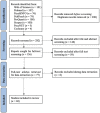Typical and Atypical Development of Visual Expertise for Print as Indexed by the Visual Word N1 (N170w): A Systematic Review
- PMID: 35844207
- PMCID: PMC9279737
- DOI: 10.3389/fnins.2022.898800
Typical and Atypical Development of Visual Expertise for Print as Indexed by the Visual Word N1 (N170w): A Systematic Review
Abstract
The visual word N1 (N170w) is an early brain ERP component that has been found to be a neurophysiological marker for print expertise, which is a prelexical requirement associated with reading development. To date, no other review has assimilated existing research on reading difficulties and atypical development of processes reflected in the N170w response. Hence, this systematic review synthesized results and evaluated neurophysiological and experimental procedures across different studies about visual print expertise in reading development. Literature databases were examined for relevant studies from 1995 to 2020 investigating the N170w response in individuals with or without reading disorders. To capture the development of the N170w related to reading, results were compared between three different age groups: pre-literate children, school-aged children, and young adults. The majority of available N170w studies (N = 69) investigated adults (n = 31) followed by children (school-aged: n = 21; pre-literate: n = 4) and adolescents (n = 1) while some studies investigated a combination of these age groups (n = 12). Most studies were conducted with German-speaking populations (n = 17), followed by English (n = 15) and Chinese (n = 14) speaking participants. The N170w was primarily investigated using a combination of words, pseudowords, and symbols (n = 20) and mostly used repetition-detection (n = 16) or lexical-decision tasks (n = 16). Different studies posed huge variability in selecting electrode sites for analysis; however, most focused on P7, P8, and O1 sites of the international 10-20 system. Most of the studies in adults have found a more negative N170w in controls than poor readers, whereas in children, the results have been mixed. In typical readers, N170w ranged from having a bilateral distribution to a left-hemispheric dominance throughout development, whereas in young, poor readers, the response was mainly right-lateralized and then remained in a bilateral distribution. Moreover, the N170w latency has varied according to age group, with adults having an earlier onset yet with shorter latency than school-aged and pre-literate children. This systematic review provides a comprehensive picture of the development of print expertise as indexed by the N170w across age groups and reading abilities and discusses theoretical and methodological differences and challenges in the field, aiming to guide future research.
Systematic review registration: https://www.crd.york.ac.uk/prospero/display_record.php?ID=CRD42021228444.
Keywords: N170; developmental reading disorder (DRD); dyslexia; event-related potentials (ERP); reading development; systematic review; visual expertise; words.
Copyright © 2022 Amora, Tretow, Verwimp, Tijms, Leppänen and Csépe.
Conflict of interest statement
The authors declare that the research was conducted in the absence of any commercial or financial relationships that could be construed as a potential conflict of interest.
Figures
Similar articles
-
Temporal dynamics of early visual word processing - Early versus late N1 sensitivity in children and adults.Neuropsychologia. 2016 Oct;91:509-518. doi: 10.1016/j.neuropsychologia.2016.09.014. Epub 2016 Sep 19. Neuropsychologia. 2016. PMID: 27659875
-
Fast, visual specialization for reading in English revealed by the topography of the N170 ERP response.Behav Brain Funct. 2005 Aug 9;1:13. doi: 10.1186/1744-9081-1-13. Behav Brain Funct. 2005. PMID: 16091138 Free PMC article.
-
Coarse and fine N1 tuning for print in younger and older Chinese children: Orthography, phonology, or semantics driven?Neuropsychologia. 2016 Oct;91:109-119. doi: 10.1016/j.neuropsychologia.2016.08.006. Epub 2016 Aug 6. Neuropsychologia. 2016. PMID: 27507119
-
Qualitative Synthesis of Young People's Experiences With Technology-Assisted Cognitive Behavioral Therapy: Systematic Review.J Med Internet Res. 2019 Nov 12;21(11):e13540. doi: 10.2196/13540. J Med Internet Res. 2019. PMID: 31714251 Free PMC article.
-
tDCS Modulatory Effect on Reading Processes: A Review of Studies on Typical Readers and Individuals With Dyslexia.Front Behav Neurosci. 2018 Jul 31;12:162. doi: 10.3389/fnbeh.2018.00162. eCollection 2018. Front Behav Neurosci. 2018. PMID: 30108491 Free PMC article. Review.
Cited by
-
Overt Word Reading and Visual Object Naming in Adults with Dyslexia: Electroencephalography Study in Transparent Orthography.Bioengineering (Basel). 2024 May 4;11(5):459. doi: 10.3390/bioengineering11050459. Bioengineering (Basel). 2024. PMID: 38790326 Free PMC article.
-
ERP Indicators of Phonological Awareness Development in Children: A Systematic Review.Brain Sci. 2023 Feb 8;13(2):290. doi: 10.3390/brainsci13020290. Brain Sci. 2023. PMID: 36831833 Free PMC article. Review.
-
Improvement of semantic processing ability of Chinese characters in school children: A comparative study based on 2009 and 2019 data.Front Neurosci. 2023 Mar 8;17:1110674. doi: 10.3389/fnins.2023.1110674. eCollection 2023. Front Neurosci. 2023. PMID: 36968480 Free PMC article.
-
Adults with reading difficulties demonstrate selective impairments in the fine neural tuning for print.Front Neurosci. 2025 Feb 11;19:1520367. doi: 10.3389/fnins.2025.1520367. eCollection 2025. Front Neurosci. 2025. PMID: 40008301 Free PMC article.
-
Selective Impairments in Fine Neural Tuning for Print in Chinese Children with Developmental Dyslexia.Brain Sci. 2023 Feb 22;13(3):379. doi: 10.3390/brainsci13030379. Brain Sci. 2023. PMID: 36979189 Free PMC article.
References
Publication types
LinkOut - more resources
Full Text Sources



